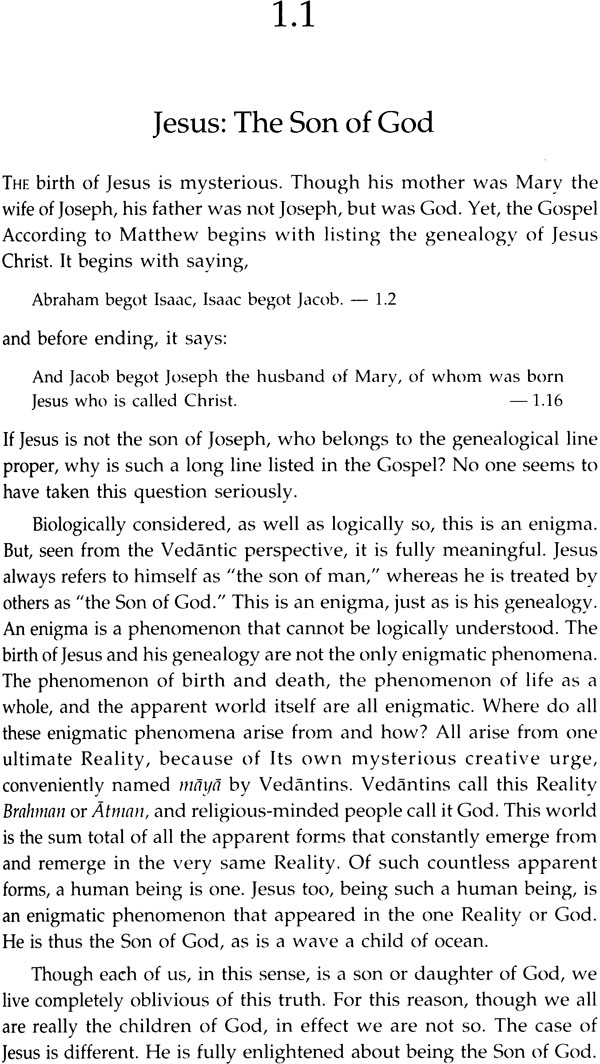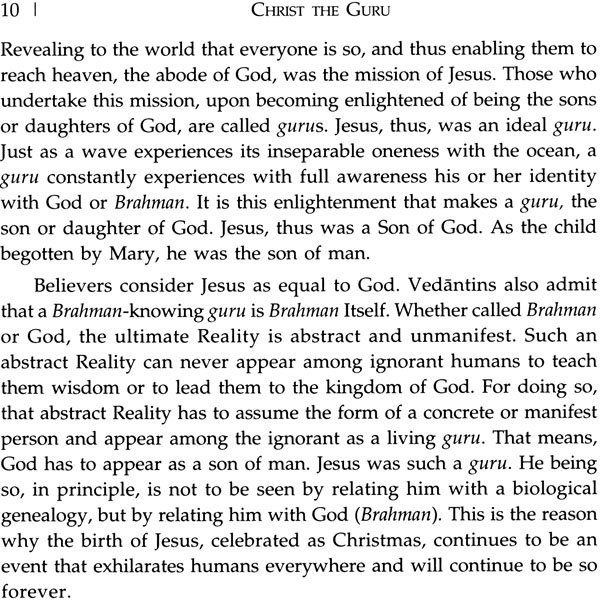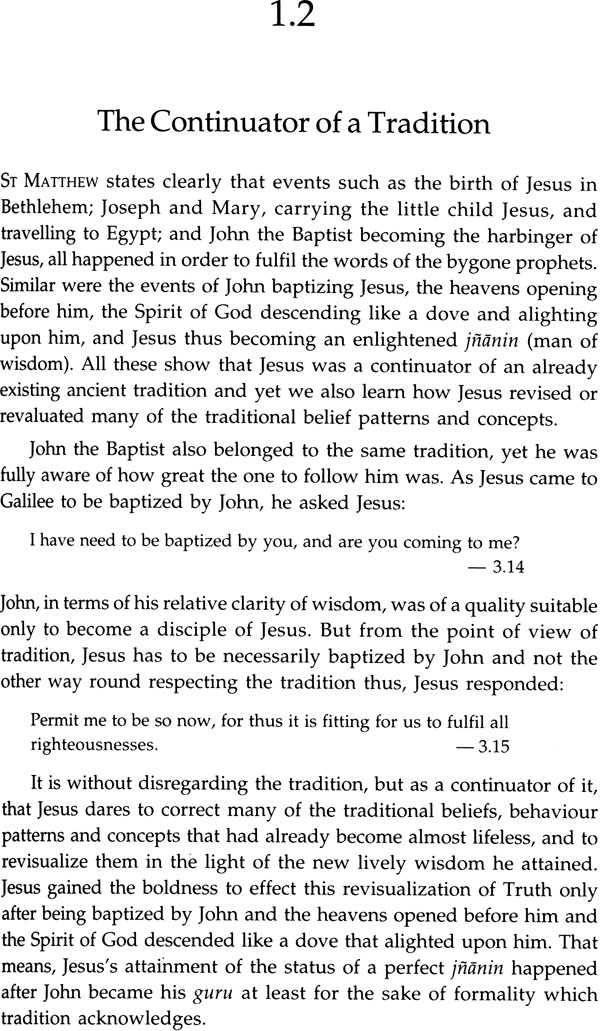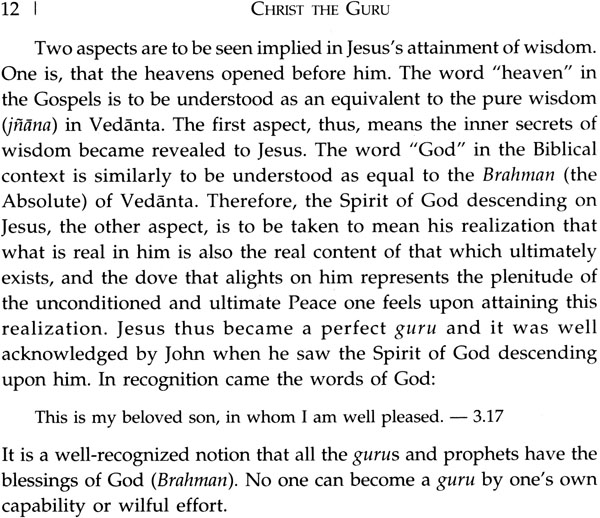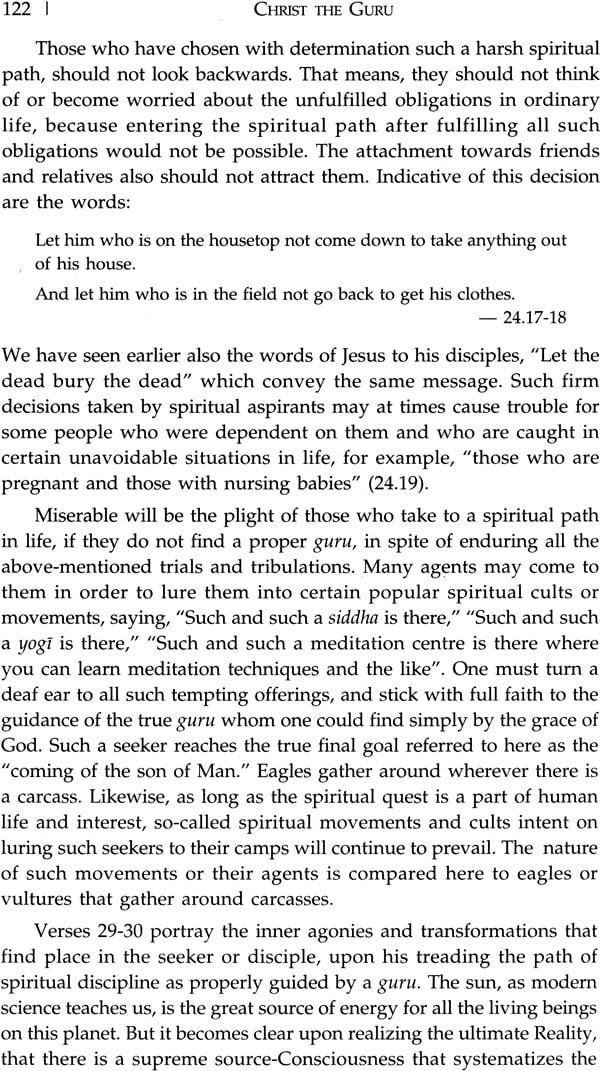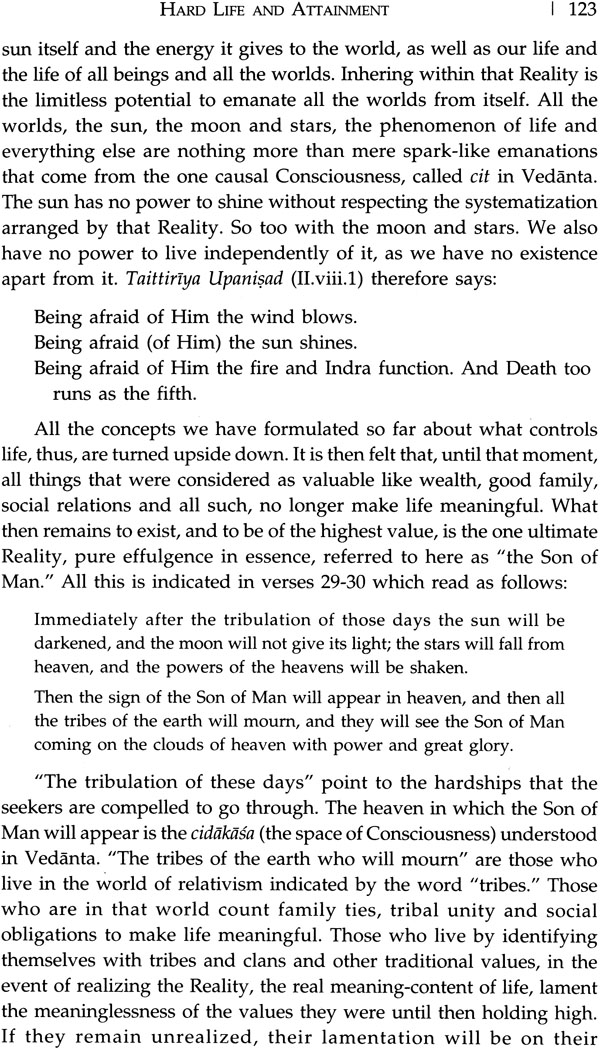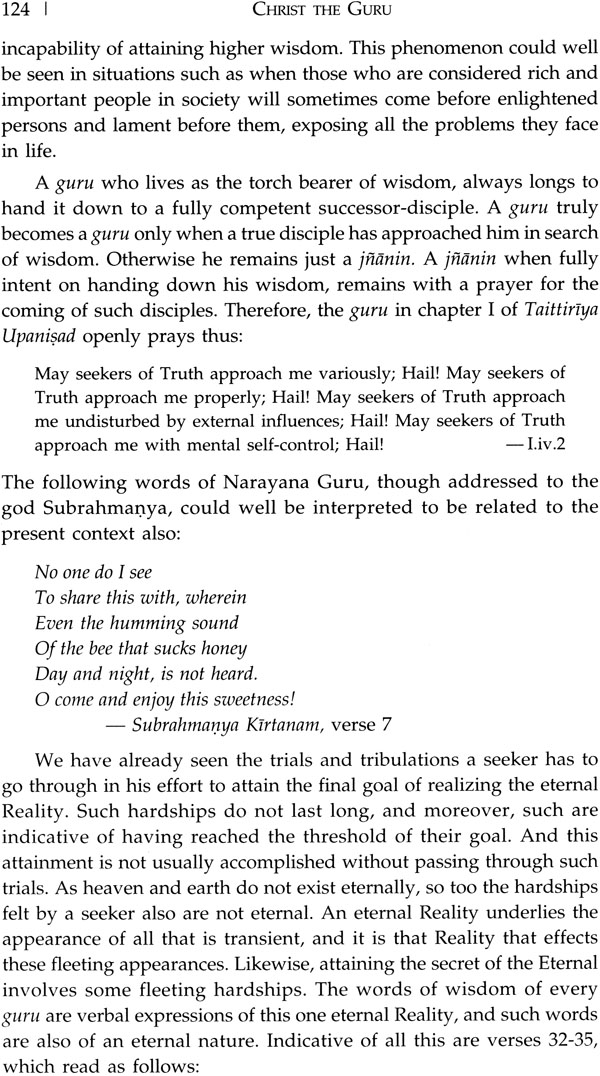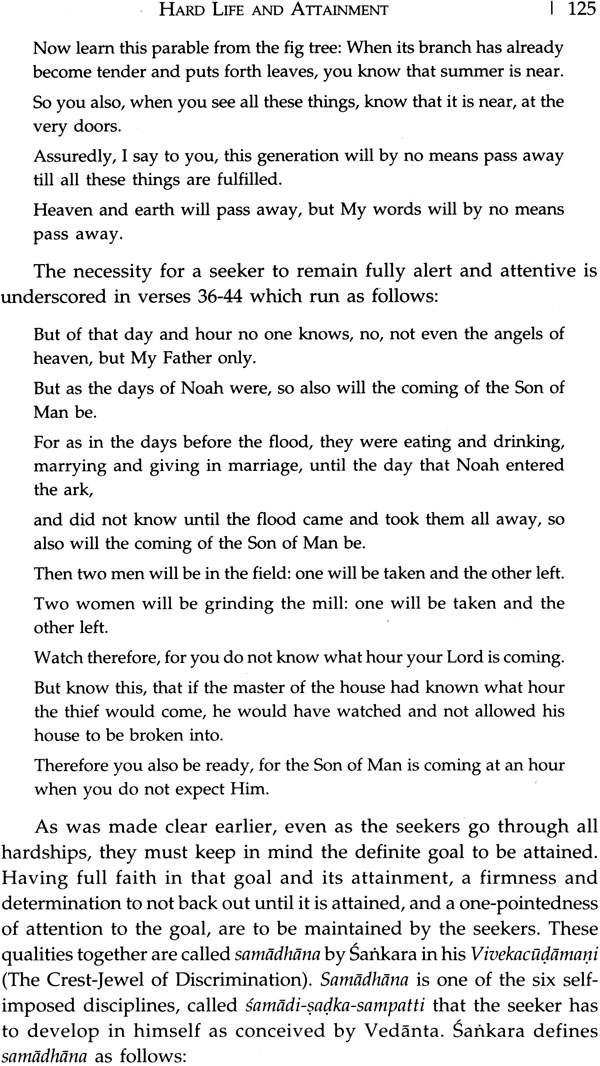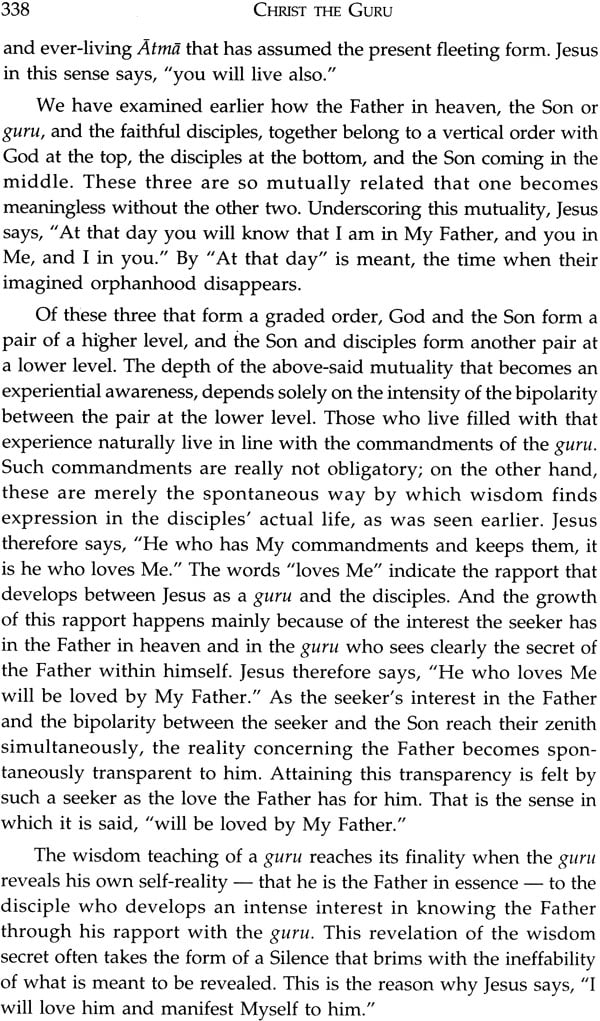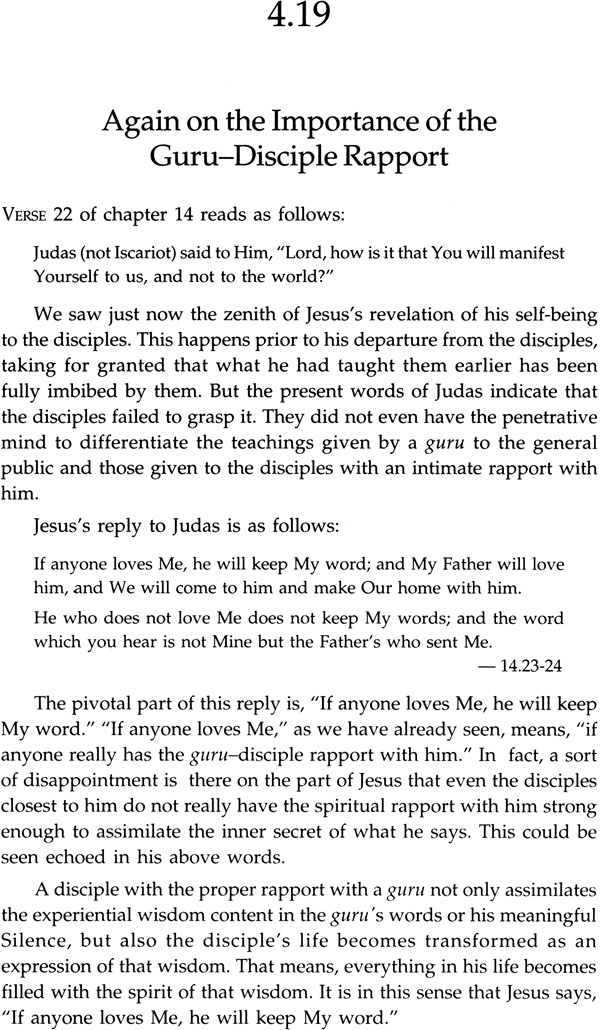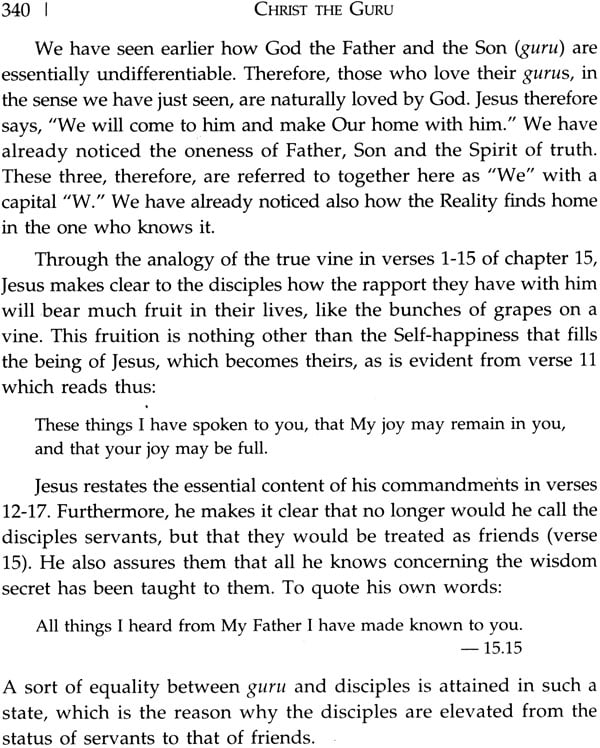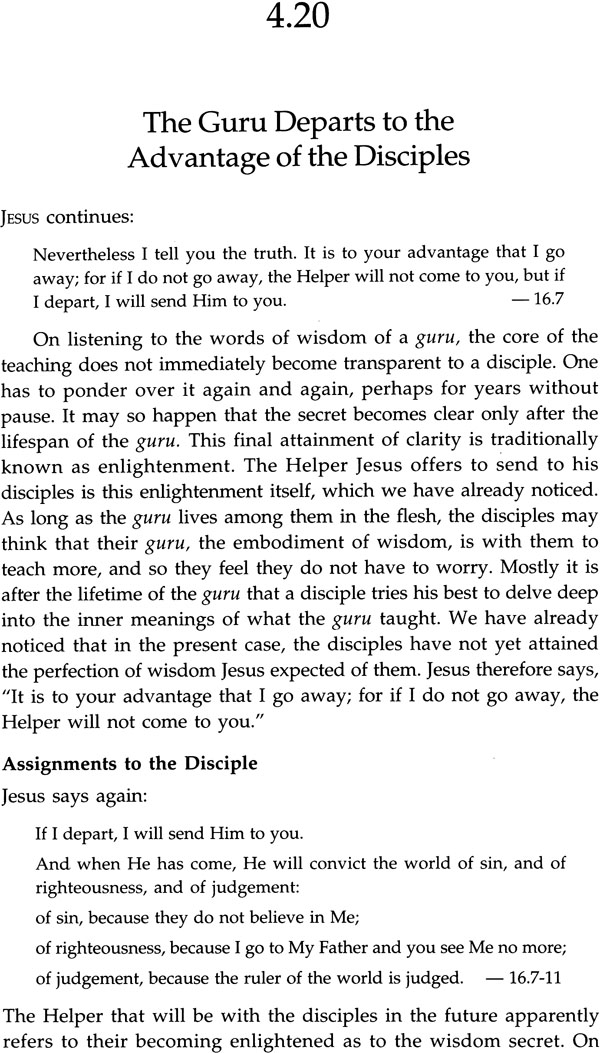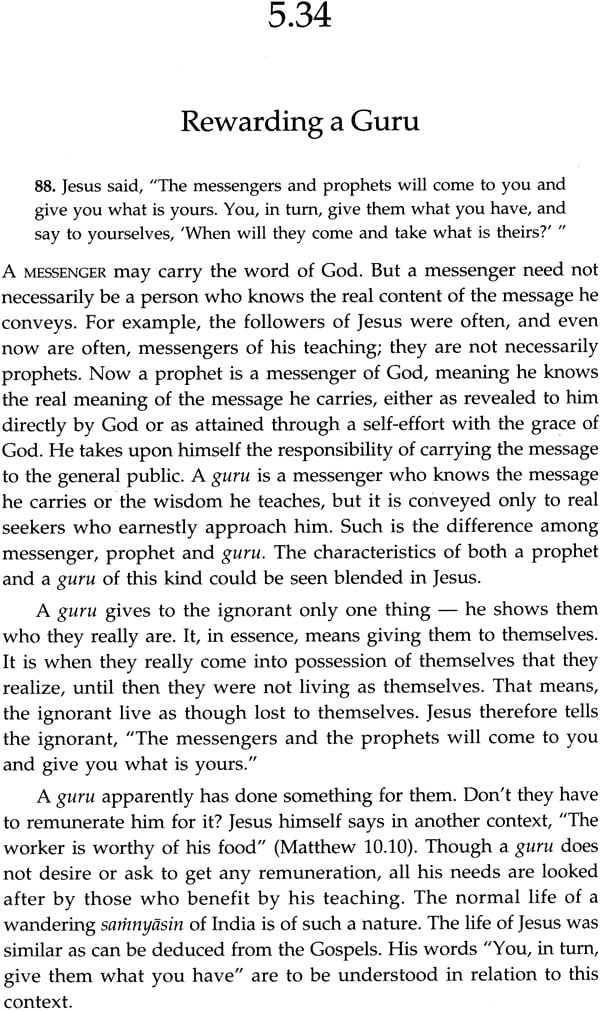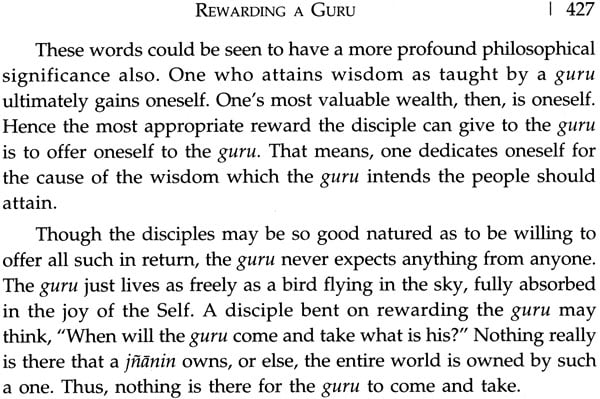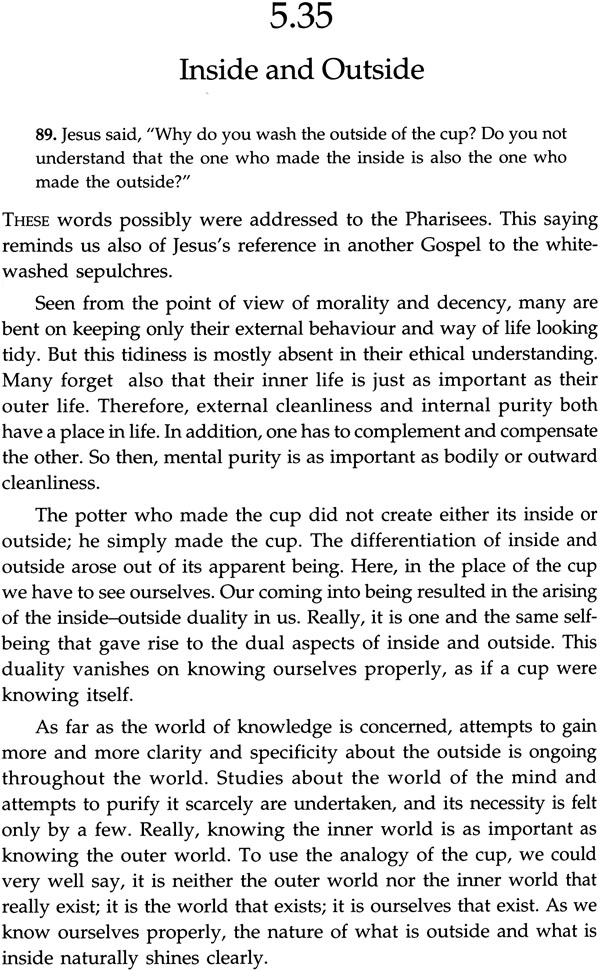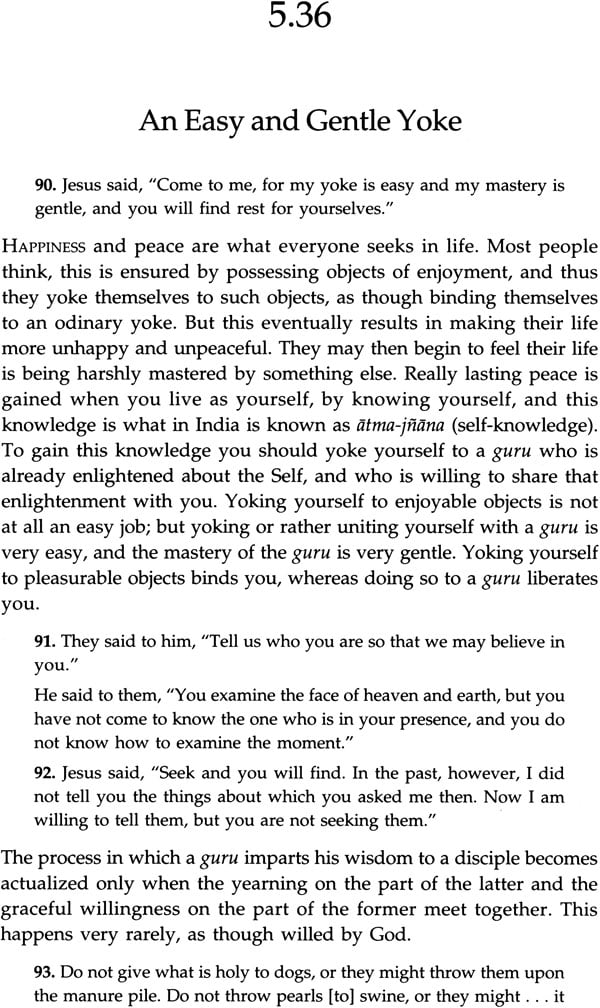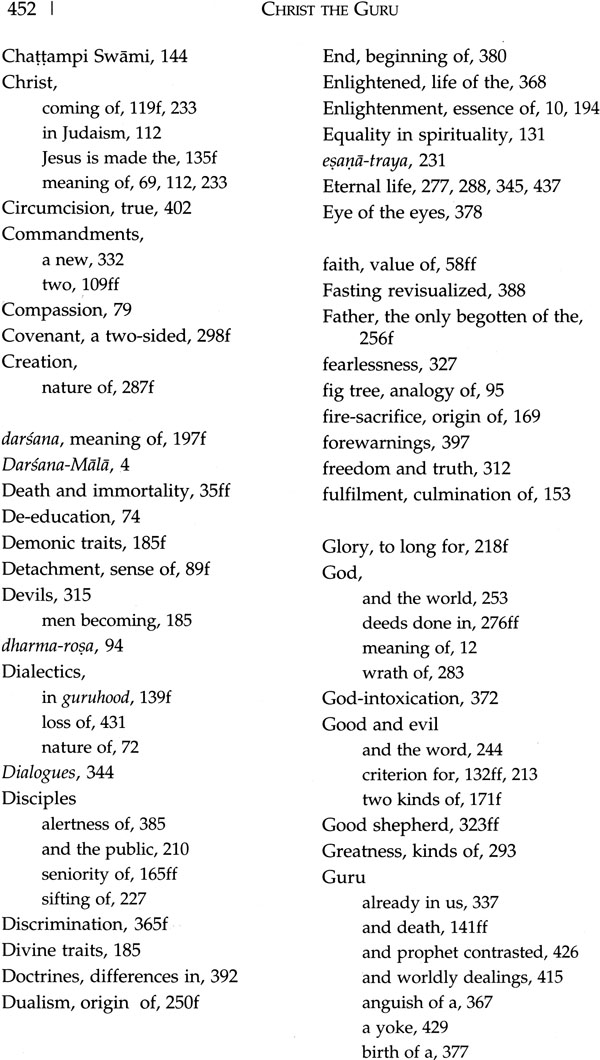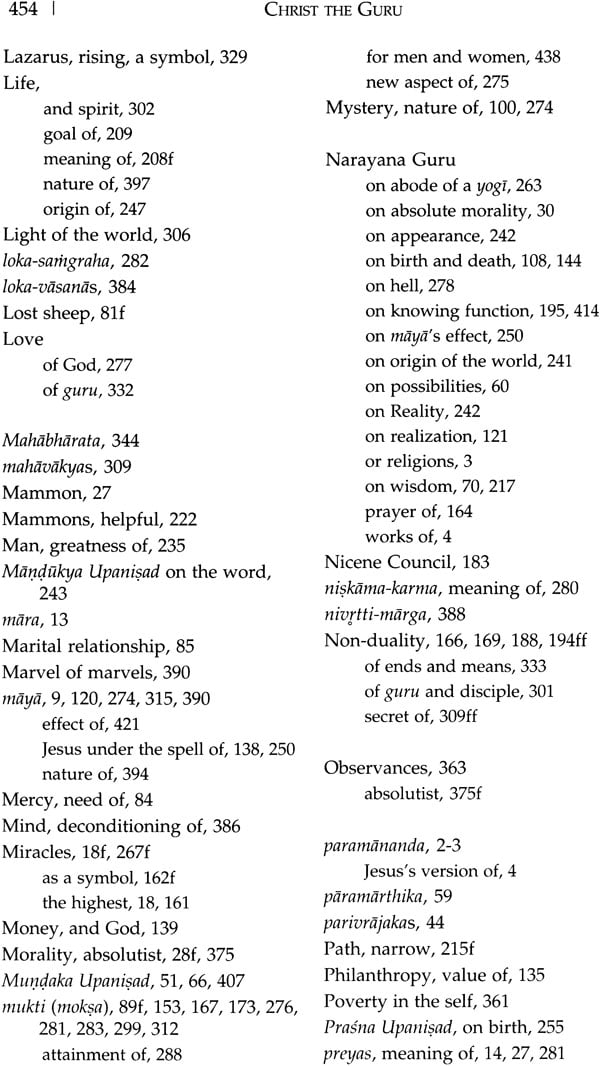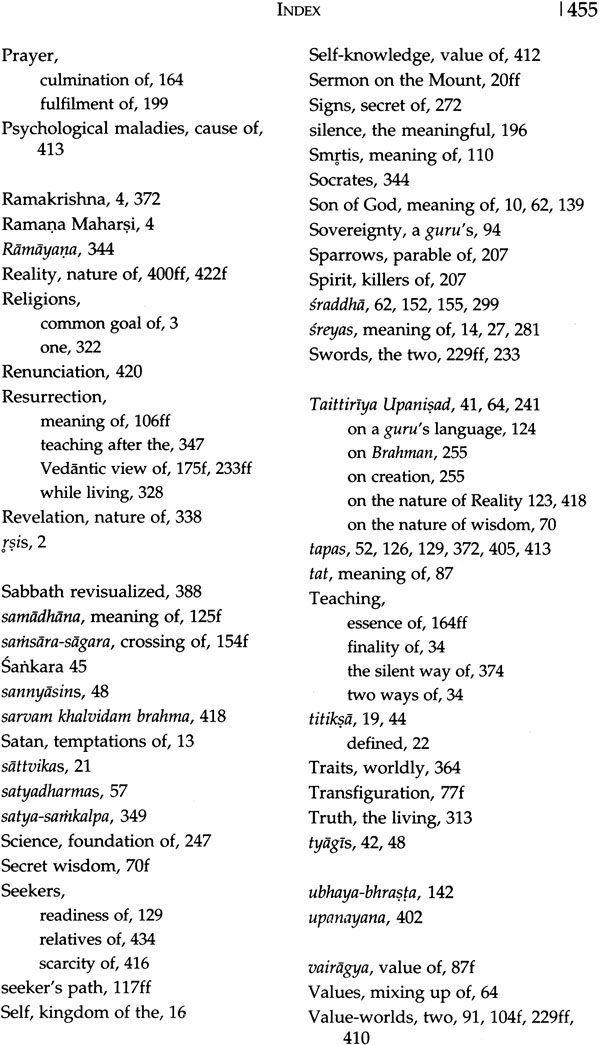
Christ The Guru (A Vedantic Key to The Gospels)
Book Specification
| Item Code: | NAH552 |
| Author: | Muni Narayana Prasad |
| Publisher: | D. K. Printworld Pvt. Ltd. |
| Language: | English |
| Edition: | 2014 |
| ISBN: | 9788124607503 |
| Pages: | 468 |
| Cover: | Hardcover |
| Other Details | 9.8 inch x 6.5 inch |
| Weight | 1.60 kg |
Book Description
The ocean of philosophical insight hiding in the words and story of Jesus Christ has influenced and charged millions of people and are still inspiring. The teaching and philosophy discerned across the four Gospels - According to Matthew, Mark, Luke and John - have stirred the philosophical perspective of Muni Narayana Prasad and it paved the way for him making a Gospel commentary in the light of Indian philosophy, Advaita Vedanta. In his scholarly attempt, the author has brought an apocryphal Gospel of Thomas too into its ambit.
Though the words of wisdom revealed by Jesus across these Gospels differ in language and style from Indian Vedanta, they reveal the same wisdom or supreme happiness that the Vedanta philosophy talks about. In this book, the author has attempted to explain the wisdom found in one cultural frame of reference as found in the other. That is, the teachings of Jesus Christ are elucidated in terms of the characteristics of Advaita Vedanta. Jesus, seen across these Gospels, always maintains his position of an enlightened seer (rsi). Thus the author calls him a sad-guru.
The author contends that from the Gospel accounts one may perceive, in Jesus's life and words, the same absolutist vision that underlies the teachings of Advaita Vedanta. Echoing interreligious harmony, the author invites the non-Christians to visit the great enlightened guru in Jesus and the Christians to imbibe the spirit of Advaita Vedanta in Jesus's teachings. A must-collect, the book should find favour with the spiritual gurus, philosophers, and all progressive-thinking persons across religions.
Swami Muni Narayana Prasad is the Guru and Head of Narayana Gurukula, a guru disciple foundation open to all, irrespective of caste, creed, gender, religion or nation, aimed at promoting the Science of the Absolute (Brahma-vidyD) as restated by Narayana Guru. A disciple of Nataraja Guru and Guru Nitya Chaitanya Yati, he has travelled widely teaching Indian philosophy. He has authored around eighty-five books in the Malayalam language. His English books are: commentaries on the Isa, Kena, Katha, Prasna, Mundaka, Mandukya, Taittiriya, Aitareya and Chandogya Upnisads, Vedanta Sutras and Darsanamala of Narayana Guru, Three Acaryas and Narayana Guru, Karma and Reincarnation, Basic Lessons on India’s Wisdom, The Philosophy of Narayana Guru, Life’s Pilgrimage Through the Gita, Collected Works of Narayana Guru, Narayanasmrtih, and Pure Philosophy Simplified for Youth.
It was during childhood that I first became acquainted with the life and ideals of the great modern sage Narayana Guru. By then he was a well- renowned philosopher-poet and social reformer of Kerala (India), my own native place. The Guru wrote his great poems of Advaita Vedanta in classical philosophical language, while his social ideals and activities were unmistakably modern in form. Yet all his diverse activities were firmly grounded in an absolutist vision of Reality. As I grew up, this auspicious familiarity with the modern sage of south India itself kindled a passion within me to study the man and his messages more intimately. Not only that, but the Tao itself seemed to be calling me to live the life of a spiritual aspirant. Then, as if by grace, the chance elements in life conspired to make me a disciple of Nataraja Guru, one of the disciples and wisdom successor of Narayana Guru. It was as a disciple of Nataraja Guru that I was guided into an understanding of the Vedanta philosophy, especially as represented by Narayana Guru.
Even as a fledgling seeker, I had become familiar with the Gospels of Christ and found them to be deeply stirring. But the ocean of philosophical insight hiding within the words and story of Jesus only became accessible to me after I had gone into the depths of Vedanta, especially under the guidance of Nataraja Guru. What was eventually needed then was the opportune time to make such a study. Later in life, the chance finally arose to plumb the depths of wisdom in the Gospels. This happened when our Gurukula began discussing the Gospels during our night classes. We decided to study and appreciate every word of Jesus in the four gospels of the Bible - Matthew, Mark, Luke and John - and also that of Thomas, one of the apocryphal gospels. The current book is the net result of that enjoyment.
My hope is that this attempt at a Gospel commentary in the light of Advaita Vedanta will be found by those who are willing to believe with an open mind in the comparative study of religions, being sure that religion is for man, and not man for religion, that is to say, those seekers of truth who are willing to look beyond the superficial differences of our spiritual traditions until they find the core, unitive principles. Those of such an attitude will undoubtedly become convinced that the essential content of all religions is one. Indeed, it is such persons who will become the true guides for our modern society, which has otherwise already shrunk into a single global village. Such is the aspiration with which this appreciation of the Gospels is presented.
I remember with gratitude all the Gurukula inmates and friends who participated in the long discussions that preceded the writing of our comments here about the words and deeds of Jesus Christ. It was from our night-time discussions that this book was born. My friend and student Ian Jaco of USA has always been with me to clarify certain background factors unknown to me. He also took much pain to carefully go through the entire text to edit it, making it a more readable book. I feel the whole experience was beneficial to both of us. A long-time associate of the Gurukula Dr Peter Oppenheimer of the US also spent a good deal of energy scrutinizing the text, making it ready for publication.
D.K. Printworld has always been willing to publish serious books on spirituality related to the Indian culture. Their service to the cause of wisdom is commendable. By the grace of the Tao all these factors have come together to bring about the publication of this book.
Of one kind, of one faith, of one God is man.
THIS is the most well-known adage of Narayana Guru. As a great axiom, it touches the Guru's sublime non-dual vision of Reality on the one side and the actualities of human life on the other. Now the words that refer to mankind as "of one kind" or "of one caste" (oru jati) are really just common sense and even modern science confirms it. Yet even the followers of the Guru doubted this idea. But the Guru leaves no room for a debate; humankind is simply one. Building upon this common sense, unitive principle further, we find another statement given by the Guru in his poem Atmopadesa Satakam (One Hundered Verses of Self-Instruction). It reads,
The essential teaching of the various religious are one alone.
In this verse we see that the religions of mankind are also essentially one. Even among the modern folk today, this idea is a difficult one to accept. But the Guru has an unshakable reason for making this striking claim. As we see a few verses later in this same work, the unitive principle implied in these statements is revealed in a final form. Thus,
Everyone in every way strives always
To attain happiness.
This faith is one in all the work
This last verse reveals that the unity of humanity is made evident by an all-underlying urge - the urge to seek the ultimate limit of happiness. Indeed, not only humans, but all beings hold happiness as the underlying drive behind all their thoughts and deeds. In this sense we can see a universal value implicit in the search for happiness itself.
As humans, we often try to attain happiness by making use of our unique gift, the thinking mind. Indeed, all of humanity's diverse ideologies and active plans are aimed just at securing greater happiness. But if we were to think carefully, what would we consider to be the truest or best kind of happiness? That is to say, is there a happiness available to us that amounts to more than the temporary forms of pleasure and security normally pursued by humanity? Is a true and lasting happiness even obtainable? And if there is; then how may it be attained? In India, the Vedanta philosophy has provided an answer for this age-old search for happiness. It is known simply as paramananda (Supreme Happiness). Although a boon to the whole world, this Supreme Happiness is not a kind of social happiness to be attained by everyone at once, as through some group effort. Surely that cannot be possible, rather, it is a personal gain.
If we hope to personally gain this paramananda, then we must carefully consider the nature of this happiness and how it is to be realized. To appreciate this, it would be prudent to take some guidance from those who have already experienced this supreme happiness. In India, such beacons are known as rsis or as gurus. Since ancient times they have indicated that supreme happiness is only to be attained by directly realizing our oneness with the total Existence. That is to say, supreme happiness can occur only when we directly perceive that what is ultimately Real in ourselves is that which is ultimately Real in the whole. To elucidate, we may use a well-known analogy in Vedanta, that of the ocean and the wave. Let us for a moment imagine a wave or endless series of waves upon some great ocean that we once visited. Obviously the apparent existence of any such wave upon the ocean would be but a fleeting one, whereas the existence of the ocean itself would be everlasting. But let us, by a stretch, further imagine that such a wave upon the ocean could perceive its own existence. Were it a wise wave, then it would surely perceive that its own existence was something that really belonged to that of the great ocean. And by such wisdom, it would naturally perceive that all the pleasures and pains of its own evanescent existence would not be things merely happening to itself alone, but would really belong to the creativity and experience of the mighty ocean itself. Now we may compare this great ocean to the absolute Reality itself. And each wave upon that ocean to an individual in this world. Just as the wise wave depicted in the analogy, a human who can perceive his or her own existence extending into the existence of the absolute Reality will in this sense be free of both pain and pleasure. Because, as we will see later, this supreme happiness is the very nature of the absolute Reality. Put otherwise, a wise person would see life's everyday experiences of mundane happiness and suffering as but the various facets of the one value or happiness (ananda) content implicit in what ultimately exists. To peacefully and neutrally perceive this ananda content of the absolute Reality abiding in our everyday experiences would be the experience of paramananda. When this direct awareness dawns, we will then perceive that all of our own actions form but a part of the actions happening in the one Reality. It is this direct perception that liberates us from what originally made us unhappy; that is, a separate sense of self that bears the burden of its own separate actions. Liberated thus, we will then perceive all of life's highs and lows as the creative self- expression of the one all-underlying Reality, called Atman or Brahman in Vedanta. It is this unchanging peace which is the highest attainable happiness for a human. But as a goal, this supreme happiness is to be attained on one's own in the here and the now, and never in the hereafter, of which nothing is yet known or knowable.
When the great religions of the world are carefully studied, it becomes obvious that all seek to teach a living wisdom that brings supreme happiness. Seen in this light, it is easy to understand the Guru's words, "The essential teachings of all the religions are one alone" (pala mata-saravum ekam). All religions then aim to help humanity attain happiness, rendering life in the here and now peaceful. As such, the differences existing between religions would then be understood to belong to what is inessential and not universal. Such differences will naturally arise in accordance with the unique historic, geographic and cultural conditions offered by their respective environments. They may be seen in the differing modes and idioms of language employed by the prophets and seers, or in the nature and traditions of the various peoples to whom they addressed their message. The possibilities for such differences are innumerable, and they may well make sense within their own setting. But all such are of a relative nature, being mostly suitable for specific conditions. Keeping these incidental factors aside, the goal of all religions is one alone - the Happiness of Man. It is in this sense also that we may understand the Guru's word, "Of one faith is man".
If we examine the words of wisdom of Jesus with such a broad outlook, then it becomes apparent that what Jesus revealed is none other than the same wisdom or supreme happiness of the Vedanta philosophy. Externally viewed though, these appear as two traditions, each with its own language and beliefs. In the case of Jesus, the language and style belong to a context familiar to the Semitic or Mediterranean culture. In Advaita Vedanta, the language and style belong to a context of the Indian culture. Now through this book, we will attempt to explain the wisdom found in one cultural frame of reference as found in another. That is to say, we will try to elucidate the teachings of Jesus Christ in terms of the characteristics of Advaita Vedanta.
Jesus, as seen in the Gospels, always maintains his position as an enlightened seer (rsi). We may also call this the position of a true guru. The word guru literally means "dispeller of darkness", and only an enlightened seer would have such an authority to enlighten us about the true nature of our life and its goal. In this sense, we see in Jesus a sad-guru (genuine guru). It is as a guru that Jesus reacts to the life situations he naturally comes across. And it is as a guru that Jesus positively teaches his disciples and the general public who follow him.
Now we do not claim this to be the only way in which Jesus's words and life may be interpreted. How a Vedantin would understand each word and deed of Jesus is alone what we attempt to clarify here. Of course, even among Vedantins, Jesus may be appreciated in various ways. But here we will attempt to demonstrate how Jesus is a Self- Realized guru par excellence. And that the purpose of the Gospels is to enlighten those who intended or still intend to follow him to the heavenly place of wisdom where he resides. Jesus did this especially well when ingeniously reacting to the everyday situations in life that arose. From these gospel accounts, we may perceive in his life and words the same absolutist vision that underlies the teachings of Advaita Vedanta. Indeed, attaining paramananda, the ultimate goal of Vedanta, and the coming of the kingdom, described by Jesus, are not two. The essence of this supreme happiness is expressed in the words of Jesus himself when he declares:
I and the Father are one. - John 10.29
We also do not mean to say that putting the comments of this book together will give an overall picture of the philosophy of Vedanta. That is to be found in the Upanisads, Bhagavad-Gita and Brahma-Sutras. In modem times, the same could be seen restated in the philosophical poems of Narayana Guru, as well as in the recorded words of Ramakrishna Paramahansa and Ramana Maharsi, In the lives and words of these modem Indian sages we also see the same peculiar method of teaching resorted to by Jesus. Some of these works mentioned, like certain Upanisads, Bhagavad-Gita and Brahma-Sutras, as well as Vedanta-Sutras and Darsana-Mala of Narayana Guru, are highly systematic in their philosophical presentation. But the Gospels do not form such a systematic philosophical treatise. They are rather a narrated, often deeply symbolic, set of records of Jesus's life and words. In this sense, they are closer in literary form to the narrated records of Ramakrishna Paramahansa and Ramana Maharsi, Although not making for a systematic treatise per se, the narration given in the Gospels does shed a clear light upon how we should perceive life's everyday situations from a non-dualistic perspective, and how we should live accordingly. It is precisely this awareness that holds the promise of supreme happiness. We hope this book will help the sincere seeker better understand the Gospels of Christ as such. Our further hope is that this study will help enable those willing enough to understand that the essential teaching of all religions is the same; and that religion is for man, and not the other way around.
We will restrict our comments to the direct teachings of Jesus as found in the four Gospels according to Matthew, Mark, Luke and John. The text we have followed has been the New King James Version of the Holy Bible published by Indian Bible Literature, Chennai, India. There were also other gospels that did not find a place in the Bible. An important one among such is the Gospel According to Thomas, discovered in 1945. We have decided to include this gospel in the present study because of its potent wisdom content. As this gospel is not very well known, the whole of the text is included along with the usual commentary. The method of interpretation for this book was to examine every parable, teaching and event in Jesus's life separately, appreciating each in light of the Vedanta philosophy. Such examinations are grouped into general subjects and presented as individual chapters. Any parable, teaching or event that had been treated prior is not repeated here. To render a study of this book fruitful, it would be most helpful to have a copy of the New Testament of the Bible opened side by side.
Although we term this book a commentary, it would be better called an appreciation, as no explication can unlock all the mystery in Jesus's words and life. Their real meaning must ultimately be perceived intuitively by the seeker.
| | ||
| | ||
| 1.1. | Jesus: The Son of God | 9 |
| 1.2. | The Continuator of a Tradition | 11 |
| 1.3. | Satan Tempts Jesus | 13 |
| 1.4. | Jesus Begins to Teach | 16 |
| 1.5. | Miracles | 18 |
| 1.6. | Sermon on the Mount | 20 |
| 1.7. | Sermon on the Mount (contd.): | 23 |
| 1.8. | Sermon on the Mount (contd.): Give Up Worldly Traits | 26 |
| 1.9. | Sermon on the Mount (contd.): Absolute Morality | 28 |
| 1.10. | Sermon on the Mount (contd.): Two Kinds of Knowledge | 31 |
| 1.11. | The Hard Life: Death and Immortality | 35 |
| 1.12. | The Harvest and the Harvesters | 38 |
| 1.13. | Directives to the Disciples | 42 |
| 1.14. | The Hidden Nature of Wisdom | 47 |
| 1.15. | The Priceless Value of Wisdom | 52 |
| 1.16. | The Value of Faith | 57 |
| 1.17. | Tradition, Purity | 62 |
| 1.18. | A Peep into the Core of Wisdom | 66 |
| 1.19. | The Insuperable Will of the Absolute | 73 |
| 1.20. | Transfiguration, Faith | 76 |
| 1.2l. | Humility, Compassion | 79 |
| 1.22. | Marital Relationships, Giving Up Attachments | 85 |
| 1.23. | Exegesis | 91 |
| 1.24. | A Humble King's Sovereignty | 94 |
| 1.25. | The Authority of Jesus | 97 |
| 1.26. | Who Becomes Enlightened? | 101 |
| 1.27. | Two Value Worlds | 104 |
| 1.28. | Resurrection | 106 |
| 1.29. | Two Commandments | 109 |
| 1.30. | Christhood | 112 |
| 1.31. | The Moral Indignation of Jesus | 114 |
| 1.32. | A Seeker's Path | 117 |
| 1.33. | Hard Life and Attainment | 121 |
| 1.34. | Incomparable Grades of Happiness | 128 |
| 1.35. | A Criterion for Good and Evil | 132 |
| 1.36. | The Final Homage | 135 |
| 1.37. | The Last Supper and Dialectics | 137 |
| 1.38. | A Guru Does not Desire to Avoid Death | 141 |
| 1.39. | Crucifixion, Resurrection | 144 |
| | ||
| | ||
| 2.1. | The Secret Nature of Wisdom | |
| 2.2. | Ignorance Vanishes in the Presence of Wisdom | |
| 2.3. | A Jnanin at His Home Town | |
| 2.4. | The Essence of the Teaching | |
| 2.5. | The Fire Sacrifices: The Two Commandments | |
| 2.6. | The Resurrection | |
| | ||
| | ||
| Introduction | ||
| Divine and Demonic Traits | ||
| John the Baptist and Jesus | ||
| 3.3. | The Unenlightened Disciples and the Uncommon Wisdom | 192 |
| 3.4. | The Fulfilment of Prayer | 199 |
| 3.5. | Demons and Priests | 200 |
| 3.6. | The Ignorant Lawmakers | 204 |
| 3.7. | Religion and Man | 206 |
| 3.8. | Disciples and the Public | 210 |
| 3.9. | A Guru's Anguish | 211 |
| 3.10. | Sin, Merit and the Greatness of Wisdom | 213 |
| 3.11. | The Kingdom of God Within and Its King | 221 |
| 3.12. | Disciples Vary in Kind | 227 |
| 3.13. | The Crucifixion and Resurrection | 233 |
| | ||
| | ||
| 4.1. | The Word and the World | 241 |
| 4.2~ | The Mission of Jesus | 252 |
| 4.3. | The First Disciples | 261 |
| 4.4. | Miracles | 267 |
| 4.5. | The Second Birth | 271 |
| 4.6. | Deeds Done in God | 276 |
| 4.7. | Unrelenting Action | 284 |
| 4.8. | Jesus Testifies About Himself | 289 |
| 4.9. | The Bread of Two Types | 294 |
| 4.10. | The Authority that Jesus Has | 304 |
| 4.11. | The Secret of Non-duality | 309 |
| 4.12. | The Competence to Gain Wisdom | 315 |
| 4.13. | The Way God Acts | 319 |
| 4.14. | One World, One Religion | 322 |
| 4.15. | One with the Selfhood of God | 327 |
| 4.16. | The Guru-Disciple Bipolarity | 331 |
| 4.17. | The Way, the Truth, the Life | 333 |
| 4.18. | The Finality of the Teaching | 337 |
| 4.19. | Again on the Importance of the Guru-Disciple Rapport | 339 |
| 4.20. | The Guru Departs to the Advantage of the Disciples | 341 |
| 4.21. | A New Language | 344 |
| 4.22. | Signature of the Evangelist | 348 |
| | ||
| | ||
| Introductory Remarks | 355 | |
| 5.1. | Prologue | 357 |
| 5.2. | The Kingdom Inside and Outside You | 359 |
| 5.3. | The Way | 362 |
| 5.4. | Religious Observances | 363 |
| 5.5. | Wordly Traits | 364 |
| 5.6. | Discriminative Power | 365 |
| 5.7. | A Guru's Anguish | 367 |
| 5.8. | The Ineffability of Wisdom | 371 |
| 5.9. | Absolutist Religious Observances | 375 |
| 5.10. | The Birth of a Guru | 377 |
| 5.11. | The Eye of the Eye | 378 |
| 5.12. | The Beginning and the End | 380 |
| 5.13. | Minuter than the Minutest, Greater than the Greatest | 383 |
| 5.14. | The Necessity of Being Strong-minded | 384 |
| 5.15. | Deconditioning the Mind | 386 |
| 5.16. | The Way to Enter the Kingdom | 388 |
| 5.17. | A Guru Grieves | 390 |
| 5.18. | Doctrinal Differences | 392 |
| 5.19. | Maya | 394 |
| 5.20. | Become Childlike | 395 |
| 5.21. | Forewarnings | 397 |
| 5.22. | The ature and Content of Reality | 400 |
| 5.23. | The Knowledge that Is Above Knowledge | 404 |
| 5.24. | The Enlightened and the Ignorant | 407 |
| 5.25. | Competence for Wisdom | 409 |
| 5.26. | The One who Is Utterly Lacking | 412 |
| 5.27. | The All-inclusiveness of Wisdom | 414 |
| 5.28. | Workers Are Few | 416 |
| 5.29. | Everything Indeed Is Brahman | 418 |
| 5.30. | Renunciation and Enlightenment | 420 |
| 5.3l. | Reality and Maya | 421 |
| 5.32. | Ordinary Men and a Guru | 423 |
| 5.33. | Self-identity with the Body | 424 |
| 5.34. | Rewarding a Guru | 426 |
| 5.35. | Inside and Outside | 428 |
| 5.36. | An Easy and Gentle Yoke | 429 |
| 5.37. | The Lapsing of Wisdom | 431 |
| 5.38. | Lift Yourself Up - | 433 |
| 5.39. | Eternal Life | 437 |
| Glossary | 439 | |
| Index | 451 |
